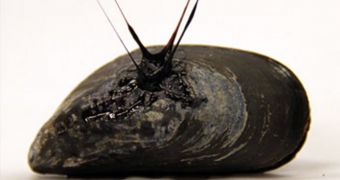A team of investigators at the University of Chicago announces the development of a new method for producing a substance that replicates the behavior and effects of a self-healing sticky substance that mussels use to anchor themselves to rocks.
The creatures also use the chemical to ensure that they are affixed to the ocean floor, or to underwater structures, in the open ocean, along shorelines, and in tidal basins. The same chemicals allow them to affix themselves to the hull of ships, increasing drag and fuel consumption.
The UC team has now managed to replicate this substance, which it hopes to use as bonding agent for medical implants, as surgical adhesive, for producing coatings for underwater structures and machines, or for making stuff stick to each other under the waves.
At this point, a patent for the new technique is pending. Researchers say that they drew inspiration from the hair-thin holdfast fibers that mussels produce in order to latch on to surfaces.
“Everything amazingly just self-assembles underwater in a matter of minutes, which is a process that’s still not understood that well,” explains UC postdoctoral scholar Niels Holten-Andersen. He works in the same research team as chemistry professor Ka Yee Lee, who is his supervisor.
Holten-Andersen says that he is fascinated with seeing how “this beautiful, amazingly huge experiment” that is life on Earth gets influenced by natural selection so that animals learn to use new materials in innovative ways over millions of years.
“The mussels that live right on the coast where the waves really come crashing in have had to adapt to that environment and build their materials accordingly,” he investigator explains.
Strength and brittleness are usually the qualities between which trade-offs need to be made when constructing synthetic coatings. But the mussel-inspired material is different.
It displays both strength and reversibility, as it replaces the usual covalent bonds with metal links. Covalent bonds appear between two atoms that share two or more electrons in common.
“These metal bonds are stable, yet if they break, they automatically self-heal without adding any extra energy to the system,” the postdoctoral researcher says.
Northwestern University professor and study co-author Phillip Messersmit was the key actor in the new achievement, as he developed the polymers whose long chains of molecules grant the material its traits.
Details of the new study were published in the latest issue of the esteemed journal Proceedings of the National Academy of Sciences (PNAS). The work was funded primarily by the US National Science Foundation and National Institutes of Health.
NASA and the Danish Council for Independent Research/National Sciences also participated in funding the research.

 14 DAY TRIAL //
14 DAY TRIAL //